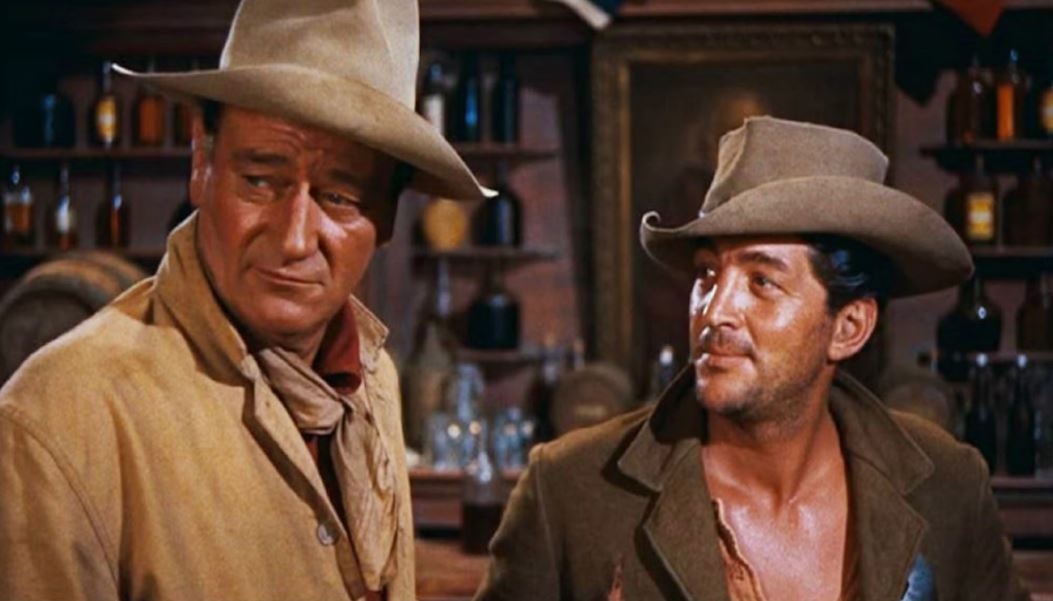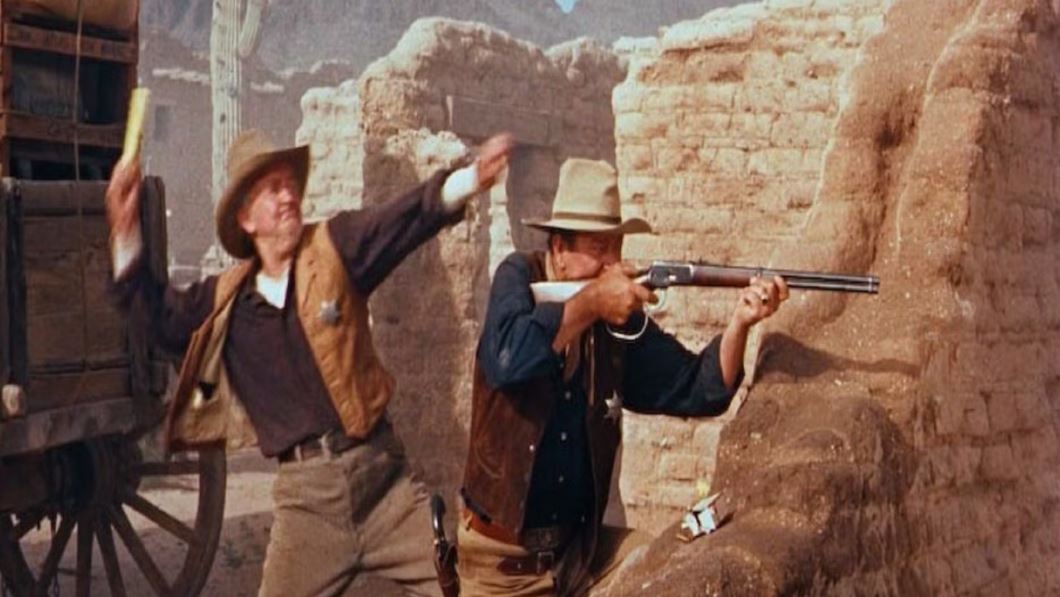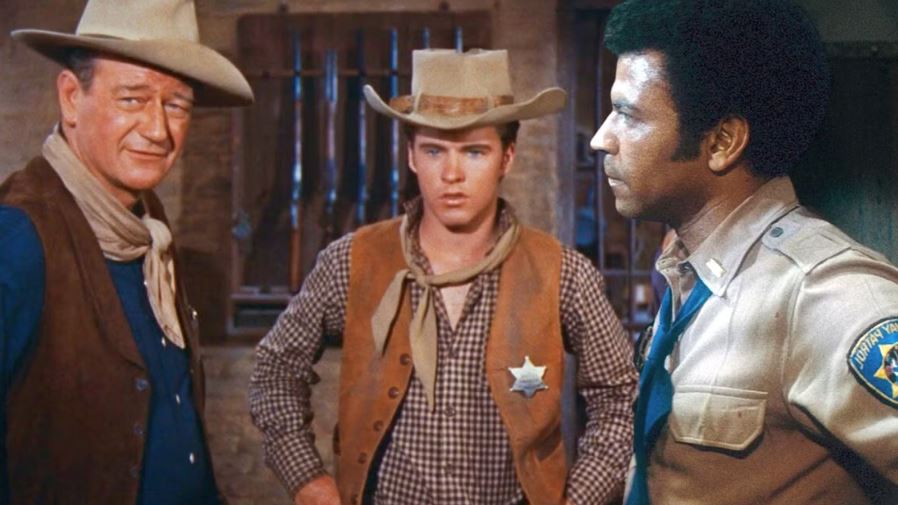John Wayne achieved major stardom with the 1939 Western film Stagecoach, which marked his first collaboration, as a leading man, with director John Ford, a relationship that reached its pinnacle with the 1956 Western film The Searchers, which is widely regarded as being the greatest and most influential Western film ever made. Ford and Wayne’s historic partnership has somewhat overshadowed another important directorial collaborator in Wayne’s career, Howard Hawks, who first directed Wayne in the classic 1948 Western film Red River. Following Red River, Ford and Wayne next collaborated on the 1959 Western film Rio Bravo, which, like The Searchers, is now regarded as being one of the greatest and most influential films, of any genre, in history.
Rio Bravo features one of Wayne’s greatest screen performances as John Chance, a small-town Texan sheriff who, after arresting the brother of a powerful local rancher for murder, has to hold the man in jail while holding off the rancher’s gang until a U.S. Marshal arrives. Joined only by a broken-down old man, a drunken former deputy, a flirtatious female gambler, and a young gunslinger, Chance struggles to maintain order in this increasingly constrictive town, in which the other citizens seemingly avoid him like the plague.
Hawks and Wayne revisited the plot of Rio Bravo with their 1966 Western film El Dorado, followed by the 1970 Western film Rio Lobo, which marked Hawks’ last feature directorial outing. However, the most compelling remake of Rio Bravo was directed by John Carpenter with Carpenter’s 1976 action thriller film Assault on Precinct 13, which, while being inspired by the plot and setting of Rio Bravo, transcended imitation and eventually gained its own distinctly influential reputation for revolutionizing the action and horror genres.
‘Rio Bravo’ Is a Masterpiece of the Western Genre

While Rio Bravo director and producer Howard Hawks had triumphed in the Western genre prior to Rio Bravo, Hawks’ direction of Rio Bravo is flawless. The leisurely-paced Rio Bravo is completely free of unnecessary shots and wasted energy. Throughout its 141-minute running time, Rio Bravo is deeply absorbing through Hawks’ economical approach, in which he establishes a palpable atmosphere and style. This makes Rio Bravo feel and look increasingly menacing, to the point where every shadow that John Wayne’s character, John Chance, encounters in the film seems to be occupied by a potential killer.
The relaxed pacing of Rio Bravo is most apparent with the humorous, warm interactions that Chance has with his small band of supporters. These include Chance’s alcoholic right-hand man Dude, touchingly well-played by Dean Martin, as well as the alluring female gambler and temptress Feathers, who, as played by the stunning Angie Dickinson, perfectly embodies the beautiful but tough-talking “Hawksian Woman” archetype.
Despite a nearly 25-year age difference between Dickinson and Wayne, Chance and Feathers have strong romantic chemistry. While Chance is reluctant to confess his true feelings for Feathers, the pair share one of the film’s most satisfying scenes in which he carries Feathers to bed after discovering that she’d fallen asleep while trying to protect him.
John Carpenter Based ‘Assault on Precinct 13’ On ‘Rio Bravo’
Assault on Precinct 13, which has been credited with launching the urban horror genre, was John Carpenter’s second feature directorial outing, following the 1974 comedy science-fiction film Dark Star. Assault on Precinct 13 showcases Carpenter’s uncanny ability to establish an eerie, horror-based tone within an action-oriented plot and setting, as later seen with Carpenter’s 1981 action science-fiction film Escape from New York.

Fast-paced, intense, and visually sharp, Assault on Precinct 13 is compelling from beginning to end. Set in and around a defunct police station within a Los Angeles ghetto, Assault on Precinct 13 features a police officer, Bishop, who must defend the isolated precinct against the seemingly endless assault of a relentless and vengeful street gang. Bishop is assisted by the precinct’s skeleton staff, along with a death-row-bound convicted murderer named Napoleon Wilson.
Assault on Precinct 13 also has a memorable Hawksian woman archetype in the form of precinct secretary Leigh, played by Laurie Zimmer. Like Angie Dickinson’s Feathers, Leigh, who was named after Rio Bravo co-writer Leigh Brackett, has a nice edgy chemistry with her immediate male counterpart in the film, the condemned Wilson, while demonstrating her bravery in the face of great danger. Sexy but tough, even after being shot, Leigh is a prototypical Hawksian woman whom Hawks and Wayne would undoubtedly have been very proud to have with them.
Carpenter Wrote a Western Script for John Wayne
In the mid-1970s, John Carpenter wrote a Western film script called Blood River, as a feature starring vehicle for John Wayne. In the script, a young gunfighter who, while fleeing the vengeful father of a man whom the gunfighter killed, is befriended by an old trapper. However, while Carpenter’s script generated enthusiasm at Wayne’s production company, Batjac Productions, Wayne, who died in 1979 at the age of 1972, was too ill to star in the film.
